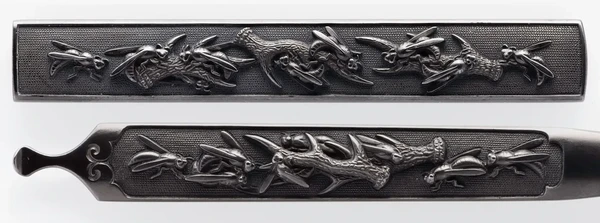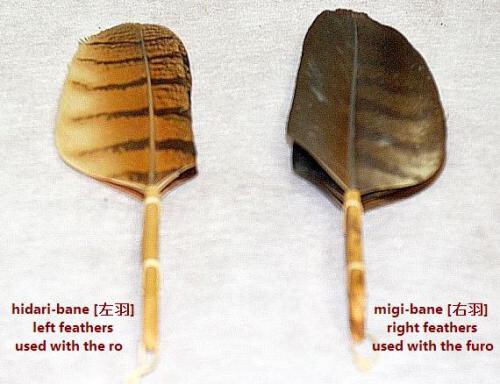-
Posts
858 -
Joined
-
Last visited
-
Days Won
7
Content Type
Profiles
Forums
Events
Store
Downloads
Gallery
Everything posted by Tanto54
-
Dear Chen Chen, looking back over this thread, I can see that you have a magnificent collection! Thanks for sharing. I particularly love the story on your new post. I wonder if this is where the story "Rip Van Winkle" comes from?
-
Hi Bob, on the design of Item No. 108, it is a rare combination of two different Shishi motifs. One is Shishi-Botan ("Liondog and Peony") which means regal or ultimate power because the Shishi is considered the King of the Beasts and the Botan (Peony) is the Queen of the Plants. The second motif is “shishi no ko otoshi” (shishi dropping its cub), where the shishi throws its young off a cliff and will only raise the cubs that survive and climb back up the cliff (tough parenting...) The motif is often represented by just the parent on a cliff or rock or the cub falling or climbing up or down a cliff (often suggesting but omitting one of these elements). Sometimes these elements are represented on different parts of the tosogu (so we shouldn't break up these sets....) This motif was to remind the Samurai to be a great leader and rigorously train themselves and their subordinates.
-
Hey Guys, Haynes 11577 uses the wrong Yoshi (吉). Bob's Yoshi is 喜, so his tsuba is by Noda Yoshihiro Haynes 11592 who worked in Edo and lived from 1693-1765. Started in the Nara School and then studied with Yasuchika. He worked for the Daimyo Matsudaira Yoshisada and was listed in the Soken Kisho. I checked the mei in Wakayama and it looks good to me.
-
Dear Bob, I really love the way that the broom wraps around on Item No. 105 and would be mostly hidden from view on the plate of the fuchi when mounted. I've seen this on many high level Japanese antiques where the artist "hides" some special aspect of the art where only the owner would ever see it.
-
Hi Patrick, Yes, they are called heat pads or trivets (nabeshiki in Japanese). If you look at the attached video of a modern casting facility in Japan, I think you will see your exact "large tsuba" for a few seconds on the shelf in the lower righthand corner at 2:11 - 2:14. https://youtu.be/a2SzEui5VVY
-
It is a modern cast trivet (heat protective coaster) made for the Japanese public (seen hundreds of them).
-
One item to consider - this tsuba is probably not a "fake" in the sense that most are supposing (a modern counterfeit). Instead, it was probably made by one of Natsuo's many students and may have even been approved for his signature. If you research Natsuo deeply, you will find that this is very common - students made much or all of a piece and then either signed the Master's name or in some cases, the Master signed himself. This is well documented with Natsuo (and many other schools). If done with the approval of the Master, then it would not be considered fake, improper or immoral in Japan. (and to avoid any misunderstanding - I'm not related to this tsuba in any way: I didn't sell or buy it, and I'm not commenting on the price...)
-
Dear Bob, when we see a wasp on tosogu it is often wordplay (which the ancient Japanese loved). One of the more common combinations is wasp and monkey which in Japanese are homophonous with “granted fiefdom” and “lord” respectively. So a monkey grasping a wasp means the good fortune of being made the lord of a fiefdom, but a monkey simply watching or ignoring a wasp means something like “don’t waste your opportunities”. See the following NMB thread for more info on that theme: https://www.militaria.co.za/nmb/topic/30375-ishiguro-masatsune-2nd-generation/ In the case of your tsuba Item No. 104, wasp can be read as Hou (or Hachi) in Japanese and deer can be read as roku (or shika). “Hou” plus “roku” makes Houroku which sounds like the word for the “stipend or salary” that a Samurai receives when starting out as a warrior. This makes your tsuba an excellent tsuba for a gift to a new Samurai. Darcy has another beautiful example and explanation of this theme here: https://yuhindo.com/goto-joshin/
- 957 replies
-
- 11
-

-

-

-
Look at Muto Masatoshi (who occasionally signed Masakatsu with this katsu and sometimes a different katsu...) from the Iwamoto School (worked in Nara style). He also uses a kakihan like this one.
-

Late Generation Kinmichi with Kiku Mon
Tanto54 replied to Kaigunto230's topic in Auctions and Online Sales or Sellers
Dear Michael, as you may know, there were 10 generations of Kinmichi. Several of the early generations are very highly regarded - the later generations not so much. Each generation has a different mei (some are quite artistic and others are very crude). The famous ones have fairly distinctive Kikumon (16 petal chrysanthemums in "windmill style" "checkerboard center", etc.) and the one you linked is clearly not an attempt to copy one of those famous ones. In addition, only certain generations used the title ("Nihon Kaji Sosho") and only some used "Raijo", so you can use that and other characteristics to narrow it down to later generations. The 10th Gen. received the title in the mid-1800's, so the sword doesn't need to be that old to be legit (therefore the bright "pillows" on mei and the nakago may not necessarily be a concern). I think that many of us cry gemei too easily. By the style of the sword and the mei, the sword is purporting to be a later generation Kinmichi. Those have never been very valuable. The sword looks OK (not great, but OK). There really isn't any reason to fake a sword with this mei (some will say that it still happens, but I don't think it happens as often as they may believe). My first sword was a 4th Gen. Kinmichi (50 years ago), so I've always been interested in this school. The mei on the sword that you linked looks like some of the crude Kikumon and mei placement that I've seen in the past on a few later generation Kinmichi. -

Late Generation Kinmichi with Kiku Mon
Tanto54 replied to Kaigunto230's topic in Auctions and Online Sales or Sellers
Dear Michael, my guess would be that it is what it purports to be - a late generation Kinmichi (not particularly valuable, but a reasonable price in my opinion). -
Dear Bob, I'd agree. If one of his many students were allowed to use his mei, I think that they would do it in the later, more common style (not the reverse order on your tsuba). I think that the same logic would apply to any forger making copies, so I think that it would probably point to yours being by Haruaki during that time period.
-
Dear Bob, on item 100, Wakayama has about 40 examples of Haruaki Hogen's mei, and all but one are in that order (Haruaki and then Hogen). However, yours has Hogen first (before Haruaki), and Wakayama says that in not typical and Haruaki only used that mei order for a limited time during the middle of his life "sonenki" (born 1787 - died 1857; he was granted the Hogen title around 40 years of age). On item 98 (the tsuba with the war fan, conch shell and "dandelion"), both the war fan (gunbai) and conch shell (horagai or jinkai) were both used for signaling on the battlefield (the gunbai is also used in Sumo for signaling the winner). I am sure that there is some deeper meaning and symbolism or wordplay going on, but it is escaping me. While the plant does look like a dandelion (tampopo), I think it might be a different flower. Hopefully someone else can figure out the meaning of this tsuba (I'll bet it is interesting....)
-
Hey Adam, I don't know where you are buying, but this is not an "authentic tsuba and mei". It's a clear counterfeit.... Knowingly selling this tsuba as authentic would be fraudulent. I hope you can get your money back.
-
Dear Adam, you mentioned that you wanted to train your tosogu eye. There is a wonderful thread on NMB that has some really great tosogu and is probably a good place to learn what good looks like (as a disclaimer, there are a very few questionable items...) Many of these are expensive, but some of them could be purchased for only 2 or 3X what you paid for that counterfeit...
-
Hey Adam, sorry that they got you... One of the casting methods that they use to counterfeit these tsuba can get all the details down to the level of your fingerprints. The counterfeits can be made for just a few dollars.
-
Dear Adam, unfortunately it is cast (recently). The story is explained in this post: I think that Dale posted multiple copies of this tsuba in some of his posts - might be in here:
-
Thanks Jean, I found it under the subfolder Nihonto Kanji Pages.
-
Dear Michael, the shapes on the back are some of the Takaramono Treasures associated with the Gods of Good Fortune. Each item has an interesting magical power. These are symbols that are often found on tosogu, kimono, etc. in Japan (but few people recognize them).
-
Dear Charles, as you may know already, your feather menuki are haboki or feather "dusters" used in the tea ceremony. You can tell because the feathers have wrapped handles. There are two different kinds of feathers used in most ceremonies depending upon which side of the feather is wider (your tanto has both). The obvious symbolism is to clean your spirit.
-
Dear Alban, instead of kendo gear, I believe your tsuba shows a samurai. What you are seeing as a "men" or kendo helmet is actually the sode (shoulder armor). I think that your tsuba shows Kanemitsu or Tomomori.
-

Elaborate Edo period koshirae / Hozon
Tanto54 replied to Fuuten's topic in Auctions and Online Sales or Sellers
The tsuba has probably been switched out - doesn't match the rest in theme or quality. -

Elaborate Edo period koshirae / Hozon
Tanto54 replied to Fuuten's topic in Auctions and Online Sales or Sellers
Hummmm, additional study may be warranted. The quality of the metal work in the bird and snake is extremely high - not the kind usually done for tourists.... As for the wrap around handle, some very old examples of this type exist.







